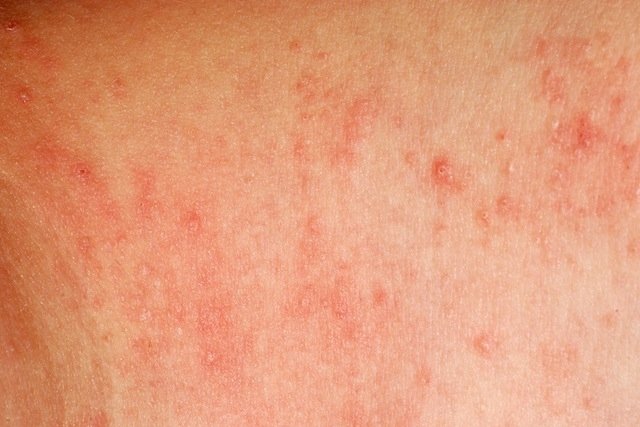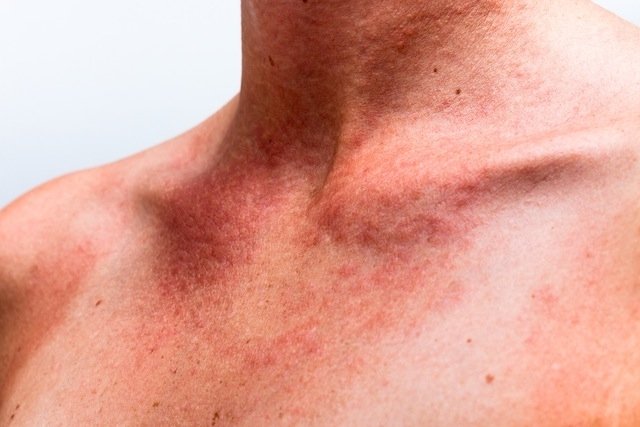Sunscreen allergy is an allergic reaction that arises due to some irritating substance present in the sunscreen, leading to the appearance of symptoms such as redness, itching and peeling of the skin, which can occur in adults, children and even babies.
As soon as the first symptoms appear, it is important that the person washes the entire area where they applied sunscreen and applies a soothing moisturizer to alleviate allergy symptoms. In addition, the dermatologist or allergist may recommend the use of antihistamines or corticosteroids depending on the severity of the allergic reaction.

Symptoms of sunscreen allergy
Although it is not very common, some people are allergic to at least one of the substances that make up sunscreen and is characterized by the appearance of symptoms in the regions where the sunscreen was applied, the main ones being:
- Itch;
- Redness;
- Peeling and irritation;
- Presence of white or reddish spots or dots.
In more serious and rare cases, allergy to sunscreen can lead to the appearance of more serious symptoms such as difficulty breathing and the feeling of something stuck in the throat, and it is important that the person goes to the hospital immediately so that these symptoms can be treated.
The diagnosis of allergy to sunscreen can be made by observing the symptoms that appear on the skin after applying the product, and it is not necessary to carry out any specific test or examination. However, the dermatologist may recommend carrying out an allergy test in order to check whether the person has any type of reaction to the substances present in the sunscreen, thus being able to recommend the most suitable protector.
Furthermore, before using a sunscreen that you have never used before, it is recommended to apply the sunscreen to a small area and leave it on for a few hours to check if any signs or symptoms of allergies appear.
Online symptom test
Sunscreen allergy is a type of allergic reaction. To find out if you have an allergy, please indicate your symptoms below:
This test is a tool that serves as a means of guidance only. Therefore, it is not intended to provide a diagnosis or replace consultation with an allergist, immunologist or general practitioner.
What to do when the first symptoms appear
As soon as the first allergy symptoms are noticed, especially in the baby, it is recommended to call or take the baby to the pediatrician so that treatment can be started quickly. In the case of children and adults, it is recommended that as soon as the first signs and symptoms of allergy appear, the areas where the protector was applied are washed with plenty of water and soap with a neutral pH. After washing, you should apply hypoallergenic products to your skin with calming agents, such as creams or lotions with chamomile, lavender or aloe vera, for example, to calm irritation and keep your skin hydrated and cared for.
If after washing and moisturizing your skin, the symptoms do not completely disappear after 2 hours or if they even worsen, it is recommended that you consult a dermatologist as soon as possible so that he or she can provide the recommended treatment for your case.
Furthermore, if your symptoms worsen and you experience difficulty breathing and a feeling of something stuck in your throat, you should go to the emergency room quickly, as this is a sign that you have a serious allergy to sunscreen.
Sunscreen allergy treatment
The recommended treatment for sunscreen allergy depends on the severity of the symptoms presented and this can be done with antihistamine medications such as Loratadine or Allegra, for example, or with corticosteroids such as Betamethasone, in the form of syrup or tablets that serve to relieve and treat allergy symptoms. Furthermore, to reduce redness and itching on the skin, the doctor may also recommend applying antihistamine ointments such as Polaramine cream, which help to reduce redness and itching on the skin.
Sunscreen allergy is a problem that has no cure, however there are some tips and alternatives that can help protect the skin of those who have already had an allergy, such as:
- Test other brands of sunscreen and try using hypoallergenic sunscreen;
- Do not sunbathe during the hottest hours, between 10 am and 4 pm.
- Go to places with lots of shade and spend as much time as possible out of the sun;
- Wear t-shirts that protect against the sun’s rays and wear a cap or wide-brimmed hat;
- Eat more foods rich in beta-carotene, as they protect the skin from the sun’s rays and prolong your tan.
Another option is to choose to use sunscreen that can be ingested, which is a vitamin juice that protects the skin from damage caused by the sun’s rays.
All of these precautions are essential, as they help protect the skin from the harmful effects caused by the sun, preventing the appearance of skin blemishes or cancer.
How to avoid sunscreen allergy
To avoid an allergy to sunscreen, it is important to do a small test before applying sunscreen all over your body, which is why it is recommended that you apply a little sunscreen behind your ears and leave it on for 12 hours without washing it off. After this time, if there is no reaction, the protector can be used without any problems.
Bibliography
- ROMERO, Valeria et al. Adverse reactions caused by the use of sunscreens. Surg Cosmet Dermatol. Vol 09. 1 ed; 41-45, 2017

Sign up for our newsletter and stay up to date with exclusive news
that can transform your routine!
Warning: Undefined array key "title" in /home/storelat/public_html/wp-content/plugins/link-whisper-premium/templates/frontend/related-posts.php on line 12
Warning: Undefined array key "title_tag" in /home/storelat/public_html/wp-content/plugins/link-whisper-premium/templates/frontend/related-posts.php on line 13




